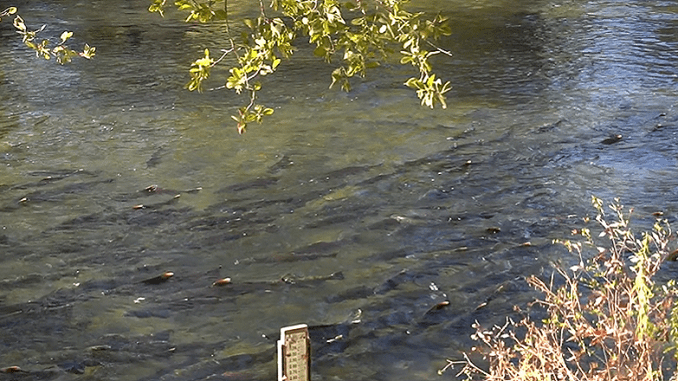
SAN FRANCISCO, California, July 18, 2022 (ENS) – In a win for conservationists and wildlife, the U.S. Court of Appeals for the Ninth Circuit has ordered new Environmental Protection Agency reviews of two Trump-era decisions to allow the use of two specific chemicals without considering their impact on endangered species such as salmon.
Today, the Ninth Circuit Court of Appeals ordered the Environmental Protection Agency to review the potential harm a toxic new fungicide from the Japanese company Sumitomo called inpyrfluxam poses to endangered species. The review must be completed by June 2023.
The EPA’s 2020 inpyrfluxam approval ignored the expert opinion of the National Academy of Sciences, which recommended the agency develop a new process to analyze risk to endangered species that was more informative and protective, the plaintiffs argued.
And on June 17, in a historic victory for farmworkers and the environment, the same appellate court overturned the Trump-era EPA decision that the toxic pesticide glyphosate is safe for humans and imperiled wildlife. Glyphosate is the active ingredient in Monsanto-Bayer’s flagship Roundup weedkiller, the most widely used pesticide in the world.
The reviews will be done by an EPA very different from that of the Trump administration.
Biden’s EPA Adopts New Pesticide Approval Policy
The EPA announced a policy for new pesticide approvals in January because previous approvals resulted in “insufficient protections” for endangered species.
“EPA must stop rubberstamping these toxic pesticides without meaningfully considering the costs and environmental harm,” said Amy van Saun, senior attorney at the San Francisco-based Center for Food Safety. “We need our government to stand up to industry pressure, comply with the law and protect the environment from dangerous pesticides.”
In April the EPA released its first-ever comprehensive workplan to address the challenge of protecting endangered species from pesticides. The plan establishes four overall strategies and dozens of actions to adopt those protections while providing farmers, public health authorities, and others with access to pesticides.

“Today’s workplan serves as the blueprint for how EPA will create an enduring path to meet its goals of protecting endangered species and providing all people with safe, affordable food and protection from pests,” said EPA Administrator Michael Regan.
“The workplan reflects EPA’s collaboration with other federal agencies and commitment to listening to stakeholders about how they can work with the Agency to solve this longstanding challenge.”
“The workplan announced today will allow us to better protect wildlife, imperiled species, and ecosystems” said White House Council on Environmental Quality Chair Brenda Mallory. “I look forward to continuing to work collaboratively across the federal government to better protect wildlife from extinction and minimize the impacts of pesticides.”
“USDA appreciates the steps EPA is taking today. We are confident that EPA can streamline Endangered Species Act consultations around pesticides in a way that continues to conserve wildlife while allowing farmers access to the tools they need to produce the food and fiber that all of us rely on,” said USDA Under Secretary for Farm Production and Conservation Robert Bonnie.
In June, the agency announced two pilot programs focused on reforming the pesticide-approval process to correct violations of the Endangered Species Act.
The Fungicide Inpyrfluxam
In June 2020, during the Trump administration, the EPA approved use of the fungicide inpyrfluxam on some of the most widely grown U.S. crops, including corn, soy, grains, beans, sugar beets, apples and peanuts.
The EPA stated then, “Inpyrfluxam adds a new mode of action against key fungal pests that can cause high yield losses to soybean and sugarbeet crops. It is also likely to play a role in fungicide resistance management on those crops. On other crops (apple, corn, peanut and rice), inpyrfluxam appears to be comparable to currently available alternative fungicides.”
EPA reviewed inpyrfluxam jointly with Canada’s Pest Management Regulatory Agency, PMRA, with Mexico as an observing member. U.S. tolerances and Canadian maximum residue limits, MRLs, are being harmonized as part of the joint review process. PMRA has not yet published its proposed decision document.
The EPA was vague about its assessment of the health risk inpyrfluxam poses to humans, saying only. “Human health risk estimates for inpyrfluxam are not of concern for all potential routes of exposure, including dietary, occupational and aggregate. The proposed registration contains several measures to mitigate ecological risks associated with the proposed uses.”
The EPA approval came despite compelling research showing the pesticide to be “very highly toxic” to fish, including endangered salmon and steelhead, and showing that it poses substantial risks to large birds, including whooping cranes. Inpyrfluxam is extremely persistent, remaining in the environment for years after use.

“I’m very pleased the court gave the EPA a firm deadline to fully explore the harm this toxic new pesticide poses to endangered species,” said Jonathan Evans, environmental health legal director at the nonprofit Center for Biological Diversity with more than 1.7 million members. “This decision should send a clear message that the EPA can no longer ignore its duty to make sure new pesticides don’t push imperiled wildlife, like salmon, closer to extinction.”
Roundup Chemical Approval Sent Back for Revision
On June 17, the U.S. Court of Appeals for the Ninth Circuit sided with the Center for Food Safety by overturning the EPA’s decision that the toxic pesticide glyphosate, the active ingredient in Roundup weedkiller, is safe for humans and vulnerable wildlife.
The Ninth Circuit’s 54-page opinion on glyphosate held the Trump administration’s 2020 interim registration of the pesticide to be unlawful because, “EPA did not adequately consider whether glyphosate causes cancer and shirked its duties under the Endangered Species Act (ESA).”
Represented by Center for Food Safety, the petitioners in the lawsuit included the Rural Coalition, Farmworker Association of Florida, Organización en California de Lideres Campesinas, and Beyond Pesticides. A consolidated case is led by Natural Resources Defense Council and includes Pesticide Action Network.
“Today’s decision gives voice to those who suffer from glyphosate’s cancer, non-Hodgkin’s lymphoma,” said Amy van Saun, senior attorney with Center for Food Safety and lead counsel in the case. “EPA’s ‘no cancer’ risk conclusion did not stand up to scrutiny. Today is a major victory for farmworkers and others exposed to glyphosate. Imperiled wildlife also won today, as the court agreed that EPA needed to ensure the safety of endangered species before greenlighting glyphosate.”
“We welcome and applaud the court on this significant decision,” said Jeannie Economos, Pesticide Safety and Environmental Health Project coordinator at the Farmworker Association of Florida, a plaintiff in the case. “While it comes too late for many farmworkers and landscapers who suffer after glyphosate exposure, we are grateful for the court’s ruling, and hope that now EPA will act quickly to protect future workers from illness and disease resulting from this toxic pesticide.”
The Ninth Circuit panel concluded that EPA flouted its own Cancer Guidelines and ignored the criticisms of its own experts. EPA’s “not likely to cause cancer” conclusion was inconsistent with the evidence before it, in the form of both real-world cancer cases and lab animal studies.
In addition to its lack of conclusion as to non-Hodgkin’s lymphoma risk, the cancer most tied to glyphosate, the court also concluded that EPA’s general “no cancer” decision was divorced from its own Guidelines and experts when EPA selectively discounted evidence that glyphosate causes tumors in animals.
At various points the court criticized EPA’s “disregard of tumor results” its use of “bare assertions” that “fail to account coherently for the evidence” making conclusions that do not “withstand scrutiny under the agency’s own framework,” and “fail[ing] to abide by” its cancer guidelines. The court ruled that EPA’s “inconsistent reasoning” made its decision on cancer “arbitrary,” and struck it down.
“We are grateful that the court decided in our favor,” said John Zippert, chairperson of the Rural Coalition, a plaintiff in the case. “We need to halt glyphosate’s devastating impact on the farmworkers and farmers who suffer the deepest consequences of exposure. This decision will hopefully hasten the transition to farming and gardening methods and practices that increase resilience, protecting our children, our planet, and all those who feed us.”
“EPA’s failure to act on the science, as detailed in the litigation, has real-world adverse health consequences for farmworkers, the public, and ecosystems,” said Jay Feldman, executive director of Beyond Pesticides, a plaintiff in the case. “Because of this lawsuit, the agency’s obstruction of the regulatory process will not be allowed to stand, and EPA should start shifting food production to available alternative non- and less-toxic practices and materials that meet its statutory duty.”
The court went on to conclude that EPA’s decision also violated the Endangered Species Act. As the court noted, EPA itself elsewhere had admitted that “glyphosate ‘may affect’ all listed species experiencing glyphosate exposure – that is 1,795 endangered or threatened species” yet had unlawfully ignored the Endangered Species Act for this decision.
As to remedy, the court struck down, or vacated the human health assessment. The court also required that EPA redo and/or finish all remaining glyphosate determinations by an October 2022 deadline, or within four months.
This includes a redone ecological toxicity assessment, a redone costs analysis of impacts to farmers from pesticide harms, as well as all Endangered Species analysis and mitigation.
EPA currently has over 50 pesticide ingredients, covering over 1,000 pesticide products, with court-enforceable deadlines to comply with the Endangered Species Act or in pending litigation alleging ESA violations. Completing this work will take EPA past 2040, yet the work represents less than five percent of all the FIFRA decisions in the next decade for which ESA obligations exist.
The EPA calls this “an unsustainable and legally tenuous situation,” in which EPA’s schedule for meeting its Endangered Species Act obligations has historically been determined through the courts. The new workplan can provide a path for the agency to meet those obligations on its own, thus protecting endangered species while supporting responsible pesticide use.
Featured image: Fall-run Chinook salmon swimming in Battle Creek at the entrance of Coleman National Fish Hatchery, Sacramento, California. October 15, 2021 (Screengrab from video courtesy Dennis Whitaker/Golden State Salmon Association)



